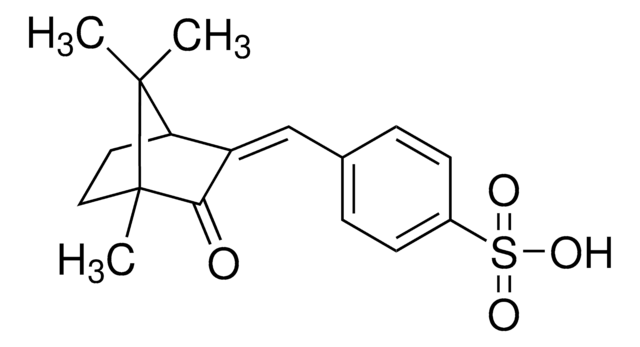This product has not been specifically tested for suitability in SCSA and sperm DNA structure assays. However, there are a number of publications that have used this product for such applications. A thorough review of the literature is recommended. Please see the link below to review one such publication:
https://www.sciencedirect.com/science/article/pii/S0188440901003289
A6014
Acridine Orange hemi(zinc chloride) salt
For nucleic acid staining in cells or gels
Sinonimo/i:
3,6-Bis(dimethylamino)acridine hydrochloride zinc chloride double salt, 3,6-Bis(dimethylamino)acridinium chloride hemi(zinc chloride salt), Basic Orange 14
Scegli un formato
CHF 95.80
Spedizione prevista il27 marzo 2025
Scegli un formato
About This Item
CHF 95.80
Spedizione prevista il27 marzo 2025
Prodotti consigliati
Livello qualitativo
Nome Commerciale
BioReagent
Stato
powder
Composizione
Dye content, ~80%
tecniche
nucleic acid detection: suitable
Solubilità
ethanol: 2 mg/mL
4 mg/mL (2-methoxyethanol (EGME))
water: 6 mg/mL (Forms a clear, dark orange or amber solution at 1mg/mL.)
Compatibilità
suitable for flow cytometry
suitable for microscopy
Temperatura di conservazione
room temp
Stringa SMILE
Cl[H].Cl[H].Cl[Zn]Cl.CN(C)c1ccc2cc3ccc(cc3nc2c1)N(C)C.CN(C)c4ccc5cc6ccc(cc6nc5c4)N(C)C
InChI
1S/2C17H19N3.4ClH.Zn/c2*1-19(2)14-7-5-12-9-13-6-8-15(20(3)4)11-17(13)18-16(12)10-14;;;;;/h2*5-11H,1-4H3;4*1H;/q;;;;;;+2/p-2
RAHGLSRJKRXOSY-UHFFFAOYSA-L
Cerchi prodotti simili? Visita Guida al confronto tra prodotti
Descrizione generale
Applicazioni
- detection of nucleic acids separated by gel electrophoresis
- fluorescence and epifluorescence microscopy
- analysis of mitochondria and lysosomes by flow cytometry
- DNA staining in apoptosis studies
Caratteristiche e vantaggi
- 120 microM of acridine orange detects 25-50 ng of purified DNA per band in gels
- differential staining of single- and double-stranded polynucleotides
Principio
Prodotti correlati
Avvertenze
Warning
Indicazioni di pericolo
Consigli di prudenza
Classi di pericolo
Muta. 2
Codice della classe di stoccaggio
11 - Combustible Solids
Classe di pericolosità dell'acqua (WGK)
WGK 3
Punto d’infiammabilità (°F)
Not applicable
Punto d’infiammabilità (°C)
Not applicable
Dispositivi di protezione individuale
Eyeshields, Gloves, type N95 (US)
Scegli una delle versioni più recenti:
Possiedi già questo prodotto?
I documenti relativi ai prodotti acquistati recentemente sono disponibili nell’Archivio dei documenti.
I clienti hanno visto anche
Articoli
Fluorescence lifetime measurement is advantageous over intensity-based measurements. Applications include fluorescence lifetime assays, sensing and FLI.
-
Is product A6014, Acridine Orange hemi(zinc chloride) salt, used for sperm chromatin structure assay (SCSA) and sperm DNA structure assay?
1 answer-
Helpful?
-
Active Filters
Il team dei nostri ricercatori vanta grande esperienza in tutte le aree della ricerca quali Life Science, scienza dei materiali, sintesi chimica, cromatografia, discipline analitiche, ecc..
Contatta l'Assistenza Tecnica.












